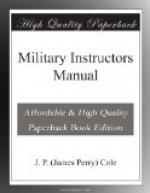men in his rear.
30. To drop quickly at end of rush and crawl up to line if in rear
of it.
31. To remain with his own company, but if he accidentally becomes
detached from his company or squad to join the nearest one.
32. To maintain silence except when transmitting or receiving firing
data and charging.
33. To retain presence of mind.
34. To be careful not to waste ammunition.
35. To use the thirty rounds of ammunition in the right pocket
section of the belt only upon the order of an officer.
36. To remain with the firing line after bringing up ammunition.
37. To utilize ammunition of dead and wounded.
38. Never to attempt to care for dead or wounded during the action.
39. To have confidence in his ability to use the bayonet.
40. To a firm determination to close with the enemy.
41. To preserve the line in charging.
42. To understand that a charge should be slow and steady (the
faster men must not run away from the slower ones).
43. To form up immediately after the charge and follow the enemy
with fire, not attempting a disorganized pursuit.
44. To understand that it is suicidal to turn his back to an enemy
and that, if he cannot advance, he must intrench and hold on
until dark.
45. To count distant groups of object or beings.
46. To recognize service targets.
47. NEVER TO FIRE UNTIL HE UNDERSTANDS WHAT THE TARGET IS, AT WHAT
PART HE IS TO FIRE, AND WITH WHAT SIGHT SETTING.
Packs.
INSTRUCTIONS FOR ASSEMBLING THE INFANTRY EQUIPMENT, MODEL OF 1910.
1. THE CARTRIDGE BELT.—(a) To assemble
the belt.
Place the adjusting strap on the
ground, eyeleted edge to the front;
place the pocket sections on the ground in prolongation
of the adjusting strap, pockets down, tops of pockets
to the front; insert end of adjusting strap in outer
loop of metal guide, from the upper side, carry it
under the middle bar and up through the inner loop;
engage the wire hook on the end of adjusting strap
in the eyelets; provided on the inner surface of the
belt.
(b) To adjust the belt.
Adjust the belt to fit loosely about
the waist—i.e., so that when
buckled it may rest well down over the hip bones on
the sides of the body and below the pit of the abdomen
in front. Care should be taken that the adjustment
be made equally from both ends of the adjusting strap,
so that the center eyelet will be in the middle of
the belt.
(c) To fill the belt.
Unsnap the flap of the pocket and
the interior retaining strap; lay
the retaining strap out flat in prolongation of the
pocket, insert a clip of cartridges, points of bullets
up, in front of the retaining strap; press down until
the base of the clip rests on the bottom of the pocket;
pass the retaining strap over the bullet points and
fasten it to the outside of the pocket by means of
the fastener provided; insert a second clip of cartridges,
points of bullets down, in rear of the first clip;
press down until the points of the bullets rest on
the bottom of the pocket; close the flap of the pocket
and fasten by means of the fastener provided.




